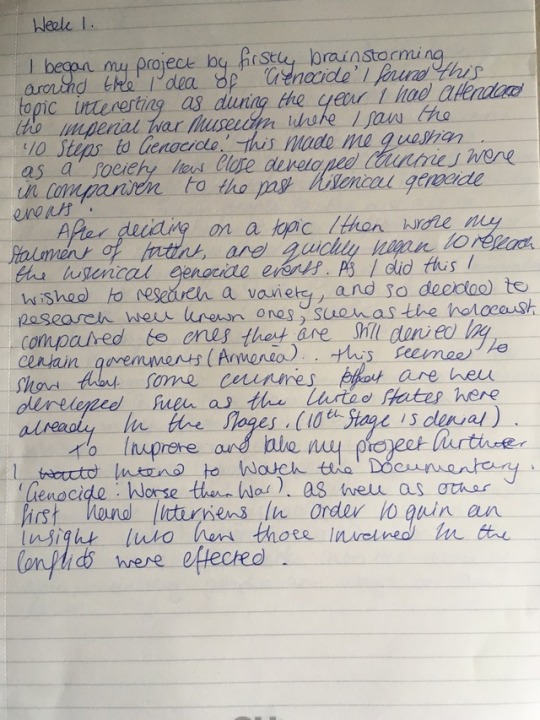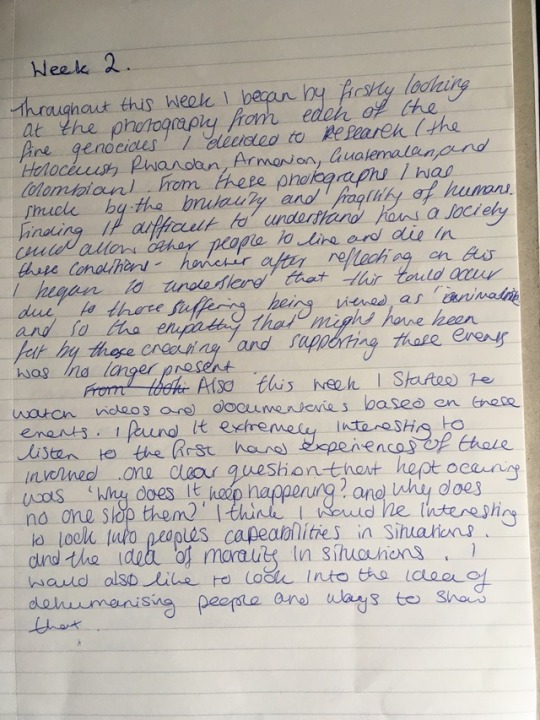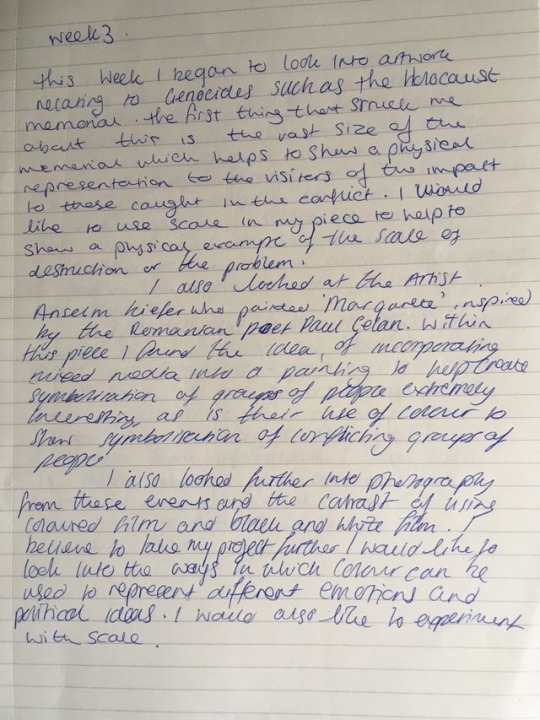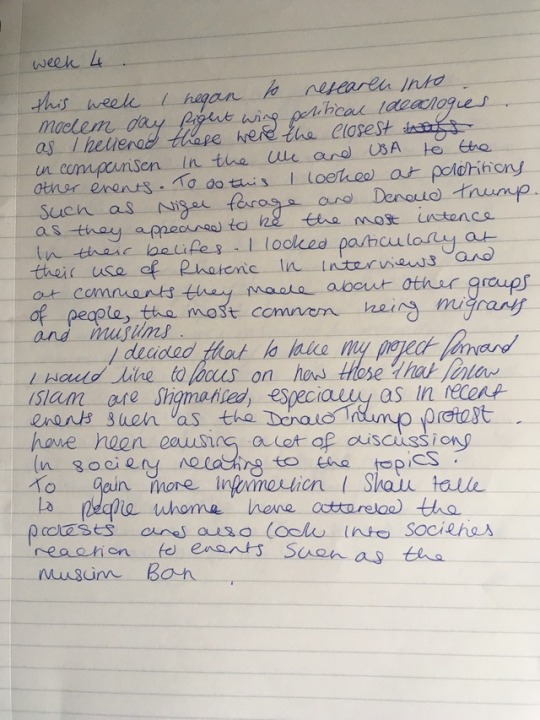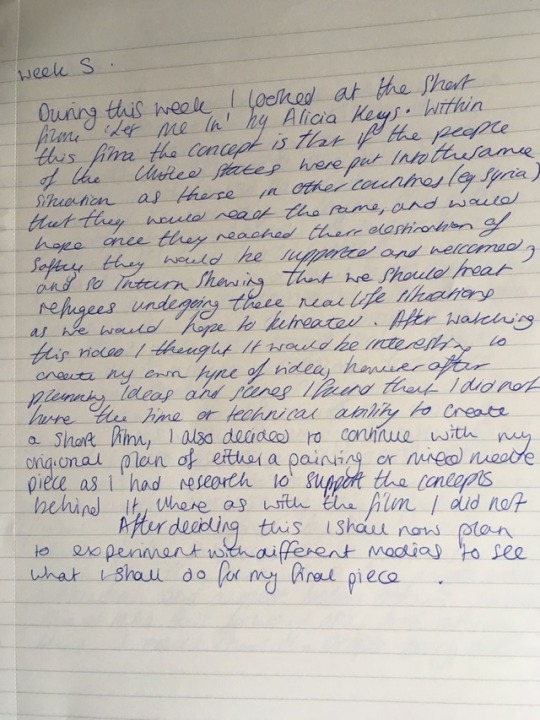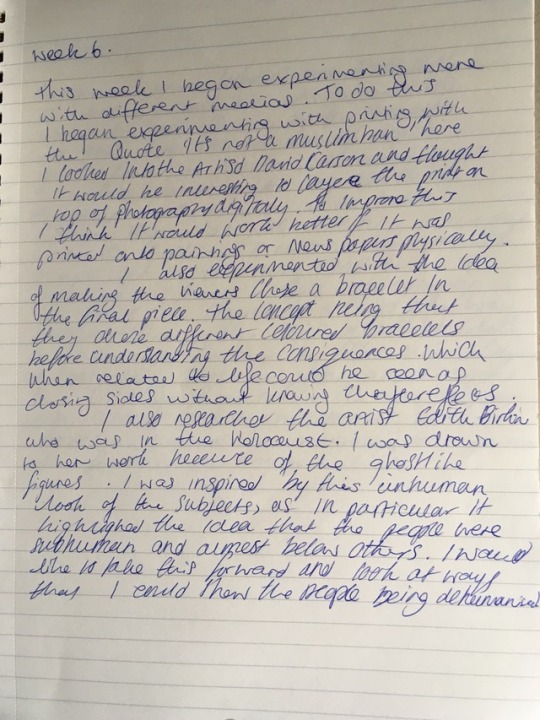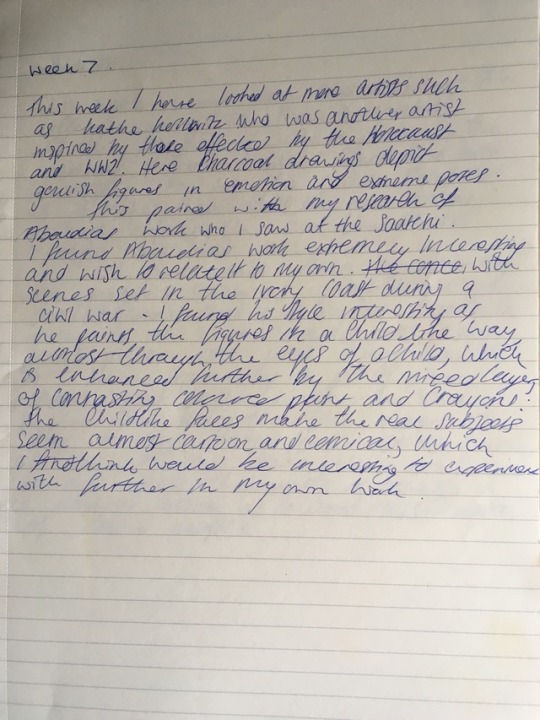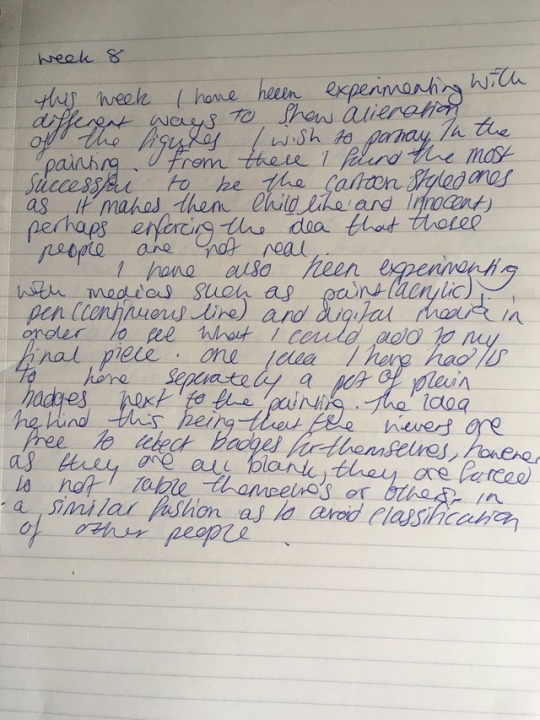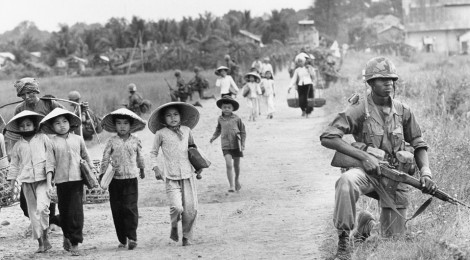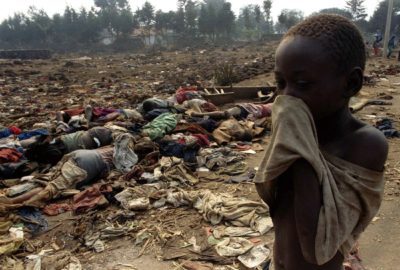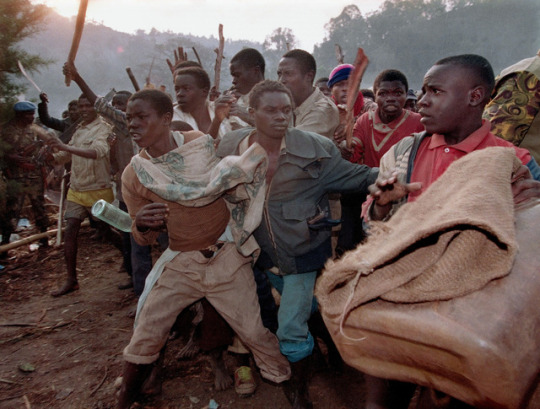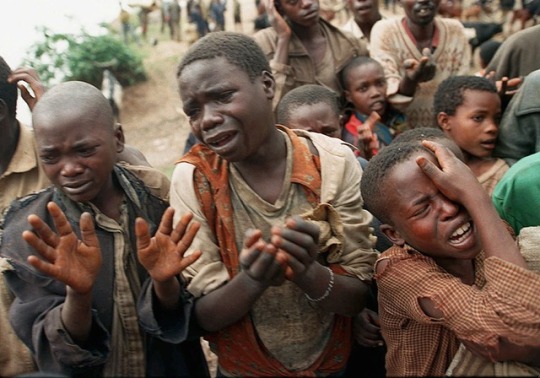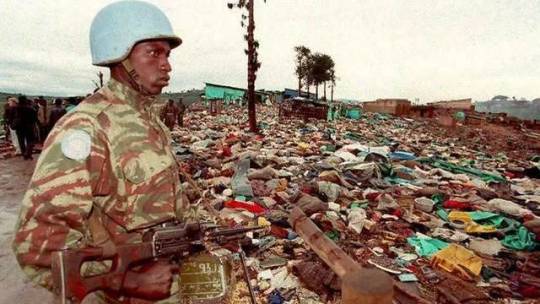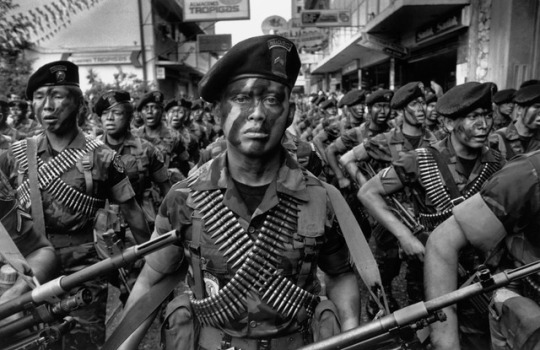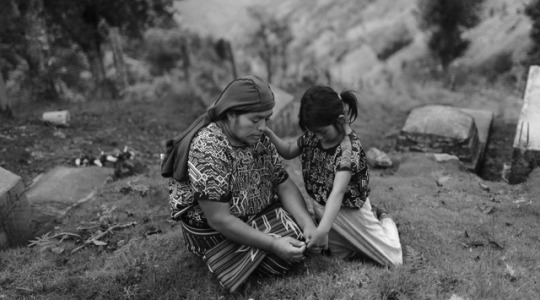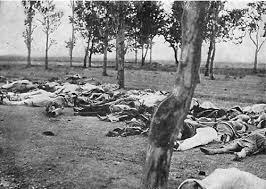Don't wanna be here? Send us removal request.
Photo

STATEMENT OF INTENT
REVIEW
Throughout this course I have explored different ways to present concepts throughout my art work, primarily experimenting with the effect contrasting medias have on dialogues between audiences and the artist. I have particularly enjoyed studying artists such as Jonathan Darby who aim to spread political awareness through visual communication and have experimented within the exploratory stage with using mixed media such as paint, newspapers and 3D medias in a similar way to him. From this unit I found that it was the concept itself and the ability to create a visual communication rather than working with a particular media that is my main motivation within my work, which has inspired my other topics such as “Parallel Language” and “Fact and Fiction”.
PROJECT CONCEPT
Having visited the Imperial war museum I was struck by similarities between the 10 stages of genocide; classification, symbolization, discrimination, dehumanization, organization, polarization, preparation, persecution and extermination. I intend to experiment visually with this idea throughout this project where I will begin my research with an investigation into the historical examples of genocide such as Armenia (1915), The Holocaust (1933) and Cambodia (1975) whilst experimenting with visual representations of “The 10 stages of Genocide”. I will also research current affairs that relate to the 10 stages, such as Donald Trump creating a Muslim Ban and the building of a wall between the United States of America and Mexico. Initially I intend to develop
EVALUATION
Symbols that can be used to create a measurement to communicate to an audience the current stages that different societies are in comparison to historical events. Having recently visited the Rauschenburg exhibition I also intend to investigate large scale multimedia and collage as a further mean of communicating my findings. I would also like to research further into interactive media and see if this would relate to this project.
POTENTIAL SOURCES
The Independent. 2017. Donald Trump using Adolf Hitler's 'Mein Kampf' playbook, says world expert on Nazi leader | The Independent. [ONLINE] Available at: http://www.independent.co.uk/news/world/americas/adolf-hitler-donald-trump-mein-kampf-bluffed-way-to-power-nazi-leader-germany-fuhrer-us-president-a7568506.html
Telegraph.co.uk. 2017. Who said it: Donald Trump or Adolf Hitler? - Telegraph. [ONLINE] Available at: http://www.telegraph.co.uk/news/worldnews/donald-trump/12038640/Who-said-it-Donald-Trump-or-Adolf-Hitler.html.
Country Profile: Colombia. 2017. Country Profile: Colombia. [ONLINE] Available at: http://genocidewatch.net/2013/03/21/country-profile-colombia/
HISTORY.com. 2017. The Holocaust - World War II - HISTORY.com. [ONLINE] Available at: http://www.history.com/topics/world-war-ii/the-holocaust
USA TODAY. 2017. Iraqi family speaks out after blocked from entering US. [ONLINE] Available at: https://www.usatoday.com/videos/news/nation/2017/01/30/iraqi-family-speaks-out-after-blocked-entering-us/97248890/.
SEN Journal: Online Exclusives. 2017. Crimes against Humanity: An Exploration of Genocide and Ethnic Violence | SEN Journal: Online Exclusives. [ONLINE] Available at: https://senjournal.wordpress.com/2011/11/18/crimes-against-humanity-an-exploration-of-genocide-and-ethnic-violence/.
Thank you Donald Trump for opposing White Genocide! – #1 - White GeNOcide Project. 2017. Thank you Donald Trump for opposing White Genocide! – #1 - White GeNOcide Project. [ONLINE] Available at: http://whitegenocideproject.com/thank-you-donald-trump-for-opposing-white-genocide-1-3/?cid=60235.
United to End Genocide. 2017. What is Genocide? The origins and naming of genocide. [ONLINE] Available at: http://endgenocide.org/learn/what-is-genocide/.
0 notes
Photo

contextual research and reflection
Here I have started to research key facts about five genocides throughout history. I decided for this research to look at a range of genocides, ranging from those that are well know to those that are still not classified by certain countries as genocides, as I hope this shall give me ore of a mix of information regard the nature of genocides. I also believe that looking at a range of different events shall allow me to identify similarities between each of them and so help me to recognize areas that are included in the 10 stages of genocide.
0 notes
Photo







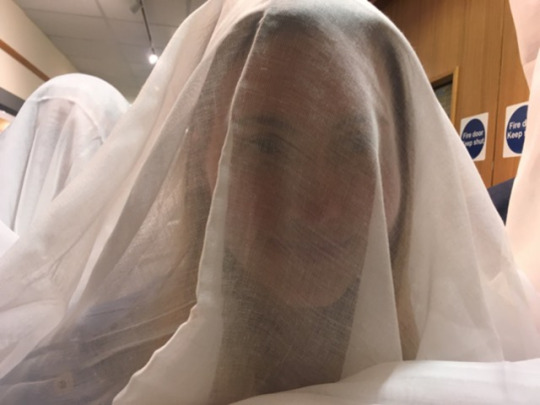


Photography
I decided to experiment with the idea of masking crowds faces in order to make them seem anonymous or defaced. This was to experiment with my first concept of removing a persons identity in order to make them seem less human. To do this I used a piece of material that still had a slight opacity to it and draped it over a selection of people faces. The outcome of this was that it produced an almost ghost like crowd where facial expressions where slightly visible but but their identity is hidden.I found this to be successful and has inspired me to look further into the idea of masking identities to dehumanise crowds of people and so remove peoples empathy towards them. I shall do this by looking into the distortion of facial features.
0 notes
Photo

reflection
To begin my project i started by firstly finishing my project proposal that states what i intend to do throughout the project, as well as the sources i intend to use and an evaluation of what i have done throughout the course.
i then began to brainstorm ideas surrounding the topic i have chosen to look into, which my initial concept being to look into how genocide is relevant to modern day society. From this i then decided to research the historical examples of genocide, varying from well known ones to ones that are relatively unknown to many people such as the Holocaust to those that some countries are still in denial about (The Armenian Genocide) .
From these i began to understand what actions lead to genocides occurring, as well as their effects on society during and after. One of the key aspects i noticed was that genocided almost always seem to occur with a political motive by the government of the country at the times. I found this particularly interesting and would like to compare the stimulus morals of the governments to modern day examples of governments.
0 notes
Photo

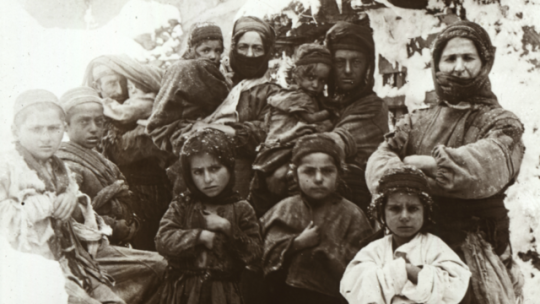


Looking At The Armenian Genocide Through the Lens of Art | The Huffington Post
Anonymous - Armenian orphans of Tarsus (Tarsi) after the Adana massacres in 1909. With permission from the Musée de la Photographie Charleroi
0 notes
Photo

HERE I WATCHED A DOCUMENTARY CALLED GENOCIDE: WORSE THAN WAR
I decided to watch this documentary as I wished to gain an insight into the experiences of those caught in the conflict from both sides of the events. I wanted to see how those who were attacked felt throughout the genocides, whilst also looking at how those who committed the crimes themselves could justify their actions. I hoped this would give me an insight into how genocides could occur as societies normally act as these events could not happen within their own countries and hopefully this documentary would help me to highlight the “10 Stages of Genocide” as events.
After watching the Documentary what interested me most was how people gained a mindset whereby they were capable of committing the crimes within genocide. This was due to them being brainwashed as a society by those in power to see a minority of the population as subhuman or animal-like and so dehumanise them. This, paired with a fear of what would happen to themselves or their families allowed them to commit crimes against these people.
Out of the “10 Stages of Genocide” this stage of “Dehumanisation” particularly interests me as i find the idea of seeing another person as inhuman an alien thought. I would like to look further into the idea of becoming dehumanised and more animalistic in a visual manner.
Quotes from the documentary.
“People need to understand that nothing is inevitable about genocide. It boils down to a series of choices, leaders choose to initiate the killing, ordinary people make a conscious choice to participate and those with the power to prevent or stop choose to do nothing”
“To kill the fish you have to drain the pond” - Guatamala
Mass hysteria - when they can know longer be accountable for their actions as they believe they must kill them yourself or their plan s to kill you. Tharcisse Karugarama (minister of justice - Rwanda)
brutality of killing is shocking once they are told they must kill the “Animals”
Serbs used rape as form of killing “Rape Camps” were created. They threatened the women and told them they would have Serbian children.
Genocide is never just about killing, its about establishing a group.
elementary politics takes different forms but leads to o conclusion.two main questions,
why does it keep happening? and why does no one stop them?
0 notes
Photo
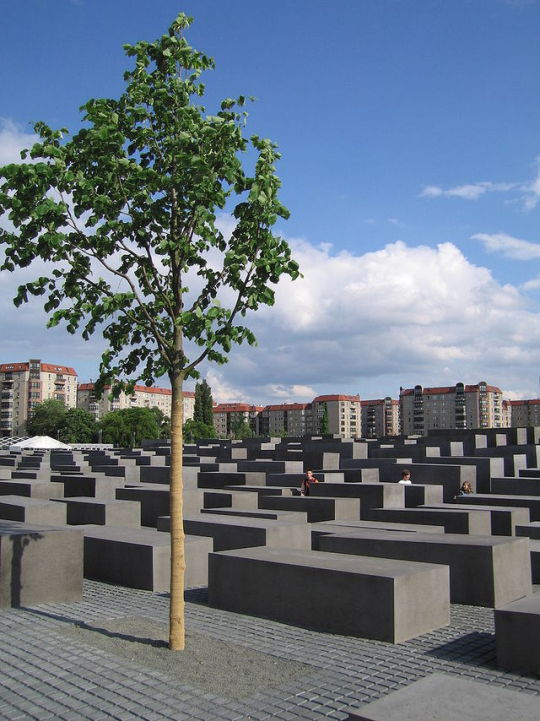


Holocaust Memorial
The photographs depict the Memorial to the Murdered Jews of Europe, also known as the Holocaust Memorial. The memorial is found in Berlin and acts as a reminder of the Jewish victims of the Holocaust. The piece was designed by architect Peter Eisenman and engineer Buro Happold. The piece its self is around 4.7 arcres in size with around 2,711 slates that are 7 ft 10 in long arranged on the field in a grid pattern. Underneath this there is an “Information Area” here the names of around 3 million Jewish holocaust Victims are written. The piece was begun in 2003, on the 1st of April and was finished on the 15th December 2004.
The first aspect of the piece to catch my eye is the scale and shape. The large size paired with the industrial concrete material creates an uneasy and eery atmosphere when looking at the repetitive blocks seen before the viewer, creating an almost never ending feeling to the rows and rows of blocks.
The piece has no certain concept, leaving the viewer to create their own idea. my interpretation of the monument is that it acts as a graveyard for those who died in the holocaust. This is due to the rows of large, grey, coffin like blocks seeming to act as resting places for those that were not given them during the Holocaust.
To take this further i would perhaps like to use a large scale in my work. This would be to highlight the amount of suffering people endured in the genocide as well as making the piece more eye catching and intimidating to the viewer.
0 notes
Photo

Margarete (1981) by Anselm Kiefer (Saatchi collection)
The Romanian poet Paul Celan was the only member of his family to survive incarceration in a concentration camp during the Holocaust, but committed suicide in 1970, at the age of 49, after producing a body of work that included the searingly painful poem, "Death Fugue". In it he talks of the inhabitants of the camp drinking black milk and digging graves in the sky. Two figures are contrasted in the poem and act as the central metaphor: Margarete, with her cascade of blonde Aryan hair, and Shulamite, a Jewish woman whose black hair denotes her Semitic origins, but which is also ashen from burning.
The theme of Celan's poem has been a preoccupation of the German artist Anselm Kiefer, for whom Margarete and Shulamite have become the metaphoric protagonists in a series of paintings, of which Margarete (1981) is the concluding work. Art and history have a complex and uncomfortable relationship within Kiefer's work. In the Seventies, he was concerned with depicting the land where historic events might have occurred. An archetypal landscape began to dominate where the earth was burnt or blackened, and the high horizon line seemed to prevent escape.
As Kiefer's 1980s series on Margarete and Shulamite evolved, like Celan, he developed a series of visual tropes to characterise the two women. Shulamite's black hair is usually painted, while Margarete's is depicted in straw embedded in the paint. Mirror images of each other, Kiefer implies that the destinies and cultures of these women were inextricably linked. Straw added to a painting of Shulamite suggests Margarete's golden tresses, while black lines or tangled areas of black paint in Margarete imply the silent, erased presence of Shulamite. For Kiefer, Germany had maimed itself by the Holocaust. By pairing these two women in paint, he attempts a restoration of wholeness.
Having exploited the metaphoric resonances of lead and sand, Kiefer first used straw in the early Eighties. With its potential to be burnt and turn to ash, it not only implied a landscape scarred and formed by history, war and fire, but also the possibility of alchemical transformation. Margarete, indicated by straw, symbolises the German love of land, and the nobility of the German soul, allowing Kiefer to play with complex notions of racial purity. The image of Margarete owes much to the vision of German womanhood created by Goethe. In Faust, Margarete (also known as Gretchen) exhibits a pure, innocent love for Faust. But love leads to a series of deceits and the killing of her own baby. While lying in prison on a bed of straw, Faust murders her brother. Thus Margarete's innocence is tainted. Goethe depicts women as sacred preservers of moral values, undone by male power, yet able to be both saved and redeemed. This is a model to which Kiefer often refers, though, for him, there's an ambivalence about the implied purity of such women.
In Margarete (1981), the name is scrawled in black across the surface like graffiti, part-prayer, part-memorial. Tendrils of straw curl upwards like smoke from death-camp chimneys, ending in candle-like flames. Meaning is ambiguous. For this flourishing crop might imply resurrection, yet the soil from which it grows is charred, while the tangles of black paint evoke the shorn piles of hair found at Auschwitz. Of his limited palette, Kiefer has said that only the French traditionally use a range of colours; as a German, he's less familiar with the practice.
Kiefer abandoned law in 1966 for art. His intellectual and artistic evolution mirrored the concerns of other German artists. He rejected the American influence of Abstract Expressionism, Pop and Minimalism to search for a German viewpoint to reflect the upheavals of the war-torn past. Moving from art for art's sake, he explored the past to learn lessons for the future. Influenced by Beuys, he saw art as a healing, spiritual process, and adopted myth and metaphor to investigate the "recent terror of history".
This impetus for examining the Nazi era may have partly derived from the 1960s spirit of revolt against the legacy of previous generations. Sensing the unaddressed presence of the Second World War everywhere within contemporary Germany, he felt compelled to confront the silent taboos of post-war German society.
These straw paintings are among the most powerful of Kiefer's works, and echo Rilke's words: "For /beauty/ is nothing but the beginning of /terror/, which we are still just able to endure." In Margarete, straw acts as a symbol for emotions stirred by the idea of land within German history. There is, Kiefer seems to imply, a dark blemish on the soul of the German nation that it will still take generations to erase.
About the artist
Anselm Kiefer was born in Donaueschingen in 1945. He studied law at Freiburg University, giving it up, in 1966, to study art. He is best known for huge paintings that deal ironically with 20th-century German history. He has developed an array of visual symbols commenting on the tragic aspects of German history, particularly the Nazi period. In the Seventies, he painted a series of landscapes that captured the sombre German countryside. In the Eighties his paintings became more physical, and featured unusual textures and materials
After researching Anselm Kiefer i was particularly interested in the use of colour to signify different meaning within the painting which was paired with mixing in other medias to support this symbolisation. I would like to include this in my work as a way on enforcing the ideas i wish to present to my audiences in order to enforce the communication of the message. I am also inspired by the use of perspective in the work and the effect it has on the viewers eye and where it goes to the painting naturally and then follow. To take these ideas forward i shall experiment with colour colour theory, and perspective.
0 notes
Photo

Article discussing Islam and America
“A series of letters was recently sent to mosques throughout California threatening genocide against Muslims. At least one of the letters read: “There’s a new sheriff in town — President Donald Trump. He’s going to cleanse America and make it shine again. And, he’s going to start with you Muslims.”
This rhetoric is emboldening hate crimes against Muslims and is making many Muslims in the U.S. fearful. Donald Trump and his advisers have only stoked the sentiment. The President-elect must rule out his campaign idea of creating a Muslim registry.
My family and I fled Iran in 1980 because we were fleeing the revolution and its aftermath, including the Iran-Iraq war. My father was worried we would be targeted by the Islamic regime newly in power because of his work representing American and European companies as a lawyer.
My mother was disturbed by the prospect of raising a daughter in an Iran she did not recognize, where groups of religious men called komitehs (committees in Persian) patrolled the streets enforcing a strict interpretation of the Islamic dress code that required all women to cover their hair as well as their arms and legs.
My parents came to the U.S. because they believed that their religion or their devotion to religion would not matter—that they would be treated equally regardless of whether we were devout Muslims like my grandmothers, or the lapsed Muslims my parents were and continue to be.
RELATED
MOVIES
Behind the Nationwide Screening of 1984
In my public school education, I learned that America stands for treating everyone equally, with respect, generosity, and an open mind, regardless of where they come from, what they look like or their religion. In law school, I learned how these values are reflected in our laws.
The idea of a Muslim registry goes against these American ideals.
Kansas Secretary of State Kris Kobach, who is reported to be a key member of President-elect Trump’s transition team, said in a November 15 interview with Reuters that Trump's policy advisers have discussed a registry for immigrants from Muslim countries.
Incoming White House Chief of Staff Reince Priebus refused to rule out such a registry when speaking on NBC's "Meet The Press".
These officials are not just talking about a registry; they are attacking an entire faith. Trump has named Mike Flynn, a man who has said that a fear of Muslims is rational, as his National Security Advisor.
When ABC’s Martha Raddatz asked Preibus whether the President-elect agrees with Flynn’s statements that Islam is not a real religion, but a political ideology masked behind a religion, Preibus said “clearly there are some aspects of that faith that are problematic.”
On Tuesday, Trump selected Katherine Gorka, a national security analyst who has been very outspoken against Islam, as part of his Department of Homeland Security (DHS) “landing team” to manage the handoff of DHS to new leadership. Gorka is known for her position that Islam itself is the problem, including her columns for Breitbart News where she has criticized Presidents Obama and George W. Bush for stating that Islam is a religion of peace. Her husband, Sebastian Gorka, also a columnist for Breitbart and a former advisor for Trump, has said that religious profiling of Muslims is “a synonym for commonsense.”
This is a huge departure from the approach America has taken since that tragic day on Sept. 11, 2001. Up until now, Republicans and Democrats alike have made it clear that the fight is against terrorism, not Islam itself.
After 9/11, President Bush distinguished between terrorists and Muslims. “The terrorists are traitors to their own faith, trying, in effect, to hijack Islam itself,” Bush said in an address to Congress on Sept. 20, 2001.
Eight days later, when meeting with the King of Jordan, Bush said: “There are thousands of Muslims who proudly call themselves Americans, and they know what I know — that the Muslim faith is based upon peace and love and compassion.”
But the Bush administration took steps that betrayed this wisdom. In 2002, they established the N ational Security Entry-Exit Registration System (NSEERS) that required men and boys 16 years of age and older with temporary visas from 25 specific countries—all but one with predominantly Muslim populations—to register for fingerprinting, photographs and invasive interviews .
The program was so unsuccessful it did not even result in a single terrorism conviction. But it did break up families as many men were either deported or fled out of intimidation.
America has been down this road before, and it did not go well. The internment of Japanese Americans during World War II is a black mark on our history that is remembered with shame.
Recently a friend of mine told me that her 7-year-old son asked why people of our faith are hated. Despite her desire to shield him from these truths, she found she had no choice but to explain that there are those who commit acts of terror in the name of Islam, but we know they are not Muslims because Islam preaches against any sort of violence. She found herself telling him that it is our duty to set those who confuse terrorists with Muslims straight.
Muslim-Americans throughout the country are having these conversations with their children. I am thankful that my son is too young for them, but often find myself tearing up when listening to the news.
Today, hearing talk that paints all Muslims with the same terrorist brush, I worry that we are abandoning American values and heading down a path that feeds right into the hands of the terrorists.
Let’s not repeat the darker pages of our history. We all must speak out against the idea of a Muslim registry regardless of our faith, creed or color. Call your elected officials or speak out to say #RegisterMeFirst.”
0 notes
Photo

The 10 stages of Genocide
1. CLASSIFICATION: All cultures have categories to distinguish people into “us and them” by ethnicity, race, religion, or nationality: German and Jew, Hutu and Tutsi. Bipolar societies that lack mixed categories, such as Rwanda and Burundi, are the most likely to have genocide. The main preventive measure at this early stage is to develop universalistic institutions that transcend ethnic or racial divisions, that actively promote tolerance and understanding, and that promote classifications that transcend the divisions. The Catholic church could have played this role in Rwanda, had it not been riven by the same ethnic cleavages as Rwandan society. Promotion of a common language in countries like Tanzania has also promoted transcendent national identity. This search for common ground is vital to early prevention of genocide.
2. SYMBOLIZATION: We give names or other symbols to the classifications. We name people “Jews” or “Gypsies”, or distinguish them by colors or dress; and apply the symbols to members of groups. Classification and symbolization are universally human and do not necessarily result in genocide unless they lead to dehumanization. When combined with hatred, symbols may be forced upon unwilling members of pariah groups: the yellow star for Jews under Nazi rule, the blue scarf for people from the Eastern Zone in Khmer Rouge Cambodia. To combat symbolization, hate symbols can be legally forbidden (swastikas) as can hate speech. Group marking like gang clothing or tribal scarring can be outlawed, as well. The problem is that legal limitations will fail if unsupported by popular cultural enforcement. Though Hutu and Tutsi were forbidden words in Burundi until the 1980’s, code words replaced them. If widely supported, however, denial of symbolization can be powerful, as it was in Bulgaria, where the government refused to supply enough yellow badges and at least eighty percent of Jews did not wear them, depriving the yellow star of its significance as a Nazi symbol for Jews.
3. DISCRIMINATION: A dominant group uses law, custom, and political power to deny the rights of other groups. The powerless group may not be accorded full civil rights or even citizenship. Examples include the Nuremberg Laws of 1935 in Nazi Germany, which stripped Jews of their German citizenship, and prohibited their employment by the government and by universities. Denial of citizenship to the Rohingya Muslim minority in Burma is another example. Prevention against discrimination means full political empowerment and citizenship rights for all groups in a society. Discrimination on the basis of nationality, ethnicity, race or religion should be outlawed. Individuals should have the right to sue the state, corporations, and other individuals if their rights are violated.
4. DEHUMANIZATION: One group denies the humanity of the other group. Members of it are equated with animals, vermin, insects or diseases. Dehumanization overcomes the normal human revulsion against murder. At this stage, hate propaganda in print and on hate radios is used to vilify the victim group. In combating this dehumanization, incitement to genocide should not be confused with protected speech. Genocidal societies lack constitutional protection for countervailing speech, and should be treated differently than democracies. Local and international leaders should condemn the use of hate speech and make it culturally unacceptable. Leaders who incite genocide should be banned from international travel and have their foreign finances frozen. Hate radio stations should be shut down, and hate propaganda banned. Hate crimes and atrocities should be promptly punished.
5. ORGANIZATION: Genocide is always organized, usually by the state, often using militias to provide deniability of state responsibility (the Janjaweed in Darfur.) Sometimes organization is informal (Hindu mobs led by local RSS militants) or decentralized (terrorist groups.) Special army units or militias are often trained and armed. Plans are made for genocidal killings. To combat this stage, membership in these militias should be outlawed. Their leaders should be denied visas for foreign travel. The U.N. should impose arms embargoes on governments and citizens of countries involved in genocidal massacres, and create commissions to investigate violations, as was done in post-genocide Rwanda.
6. POLARIZATION: Extremists drive the groups apart. Hate groups broadcast polarizing propaganda. Laws may forbid intermarriage or social interaction. Extremist terrorism targets moderates, intimidating and silencing the center. Moderates from the perpetrators’ own group are most able to stop genocide, so are the first to be arrested and killed. Prevention may mean security protection for moderate leaders or assistance to human rights groups. Assets of extremists may be seized, and visas for international travel denied to them. Coups d’état by extremists should be opposed by international sanctions.
7. PREPARATION: National or perpetrator group leaders plan the “Final Solution” to the Jewish, Armenian, Tutsi or other targeted group “question.” They often use euphemisms to cloak their intentions, such as referring to their goals as “ethnic cleansing,” “purification,” or “counter-terrorism.” They build armies, buy weapons and train their troops and militias. They indoctrinate the populace with fear of the victim group. Leaders often claim that “if we don���t kill them, they will kill us.” Prevention of preparation may include arms embargos and commissions to enforce them. It should include prosecution of incitement and conspiracy to commit genocide, both crimes under Article 3 of the Genocide Convention.
8. PERSECUTION: Victims are identified and separated out because of their ethnic or religious identity. Death lists are drawn up. In state sponsored genocide, members of victim groups may be forced to wear identifying symbols. Their property is often expropriated. Sometimes they are even segregated into ghettoes, deported into concentration camps, or confined to a famine-struck region and starved. Genocidal massacres begin. They are acts of genocide because they intentionally destroy part of a group. At this stage, a Genocide Emergency must be declared. If the political will of the great powers, regional alliances, or the U.N. Security Council can be mobilized, armed international intervention should be prepared, or heavy assistance provided to the victim group to prepare for its self-defense. Humanitarian assistance should be organized by the U.N. and private relief groups for the inevitable tide of refugees to come.
9. EXTERMINATION begins, and quickly becomes the mass killing legally called “genocide.” It is “extermination” to the killers because they do not believe their victims to be fully human. When it is sponsored by the state, the armed forces often work with militias to do the killing. Sometimes the genocide results in revenge killings by groups against each other, creating the downward whirlpool-like cycle of bilateral genocide (as in Burundi). At this stage, only rapid and overwhelming armed intervention can stop genocide. Real safe areas or refugee escape corridors should be established with heavily armed international protection. (An unsafe “safe” area is worse than none at all.) The U.N. Standing High Readiness Brigade, EU Rapid Response Force, or regional forces -- should be authorized to act by the U.N. Security Council if the genocide is small. For larger interventions, a multilateral force authorized by the U.N. should intervene. If the U.N. is paralyzed, regional alliances must act. It is time to recognize that the international responsibility to protect transcends the narrow interests of individual nation states. If strong nations will not provide troops to intervene directly, they should provide the airlift, equipment, and financial means necessary for regional states to intervene.
10. DENIAL is the final stage that lasts throughout and always follows a genocide. It is among the surest indicators of further genocidal massacres. The perpetrators of genocide dig up the mass graves, burn the bodies, try to cover up the evidence and intimidate the witnesses. They deny that they committed any crimes, and often blame what happened on the victims. They block investigations of the crimes, and continue to govern until driven from power by force, when they flee into exile. There they remain with impunity, like Pol Pot or Idi Amin, unless they are captured and a tribunal is established to try them. The response to denial is punishment by an international tribunal or national courts. There the evidence can be heard, and the perpetrators punished. Tribunals like the Yugoslav or Rwanda Tribunals, or an international tribunal to try the Khmer Rouge in Cambodia, or an International Criminal Court may not deter the worst genocidal killers. But with the political will to arrest and prosecute them, some may be brought to justice.
http://www.genocidewatch.org/genocide/tenstagesofgenocide.html
0 notes
Photo

Group Critique
From our group critique I found that my primary historical research surrounding the different types of genocide is strong, as i have looked at a range of different events and their causes. I have also looked at different medias such as paintings, documentaries and also photography which has been successful as it has allowed me to look at different ways ideas around a similar topic can be interpreted and then presented.
To take my project further it was suggested that i go to the Beth Shallom holocaust museum in Nottingham, and also the Imperial war museum in London which i intend to do over the Easter holidays.
I have also been given different ideas as to how i could take my project further. One idea suggested for my final piece was to look at the crimes committed during the genocides and place them in contrast to crimes committed by individuals and look at the juxtaposition sentences given to each person. another idea is to create an installation piece that makes the viewer question how they would react if a genocide occurred within their country. I think both ideas are good and help with my concept, and i shall look into both ideas at more depth in the next week in order to help inform my final piece ideas.
-http://www.genocidewatch.org/genocide/tenstagesofgenocide.html
0 notes
Photo


Lecture and Book - Rudi Oppenheimer
On the 19th of April 2016 I attended a Lecture at The Kings School Peterborough where Rudi Oppenheimer discussed his survival through The Holocaust. after listening to his story and then reading his book I now believe this to be one of the reasons i was so interested in Genocides as i found the lecture to be extremely moving as I heard about him and his families struggle to survive. I found it difficult to hear how young children undergo such suffering and are forced to make difficult decisions at the expense of others they care about. One moment I remember clear was of Oppenheimer relaying how his brother (Paul) and himself worked in the kitchen at the concentration camp. As the months went on they began to starve and so when serving the potato soup to the camp would leave the skins of the vegetable sat the bottom of the containers for himself and his family.
0 notes
Photo

“Let me in”
“Let Me In” was created by by Alicia Keys and her “we are here “ movement for world refugee day. The short film was directed by Jonathan Olinger and depicts an American family attempting to flee a conflict zone to an area of safety, much like that of refugees in other countries such as Syria. Through this video Alicia Keys aims to get the public to “ stand as one with people forced to flee conflict and disaster.”
"I was stunned when I learned that there are more refugees living in the world today than at any other point in history, and half of them are children," Keys said in a statement. "Creating this film really allowed us to imagine, what if we were the refugees? What if we were the ones torn from the arms of our families and loved ones? How would it feel if this were happening to us?"
The video itself forces the viewer to visualise themselves in the main characters position and question how they themselves would react in these situations. This creation of empathy allows the view to connect with the refugees on a personal level, as they have seen themselves in these positions. These therefor reduces the alienation of the refugees, and in turn remind the viewer that they are human.
These relate directly to the stage “dehumanisation” and tackles the idea that the refugees are being alienated from the rest of the world. This could be due to society becoming numb to seeing people die on the news repetitively or because the conflict is so far away they can pretend it does not exist. I find the idea from the video of bridging the differences by making the viewer picture themselves in the refugees shoes interesting and would like to take this idea further.
youtube
0 notes
